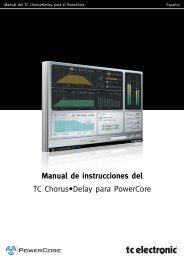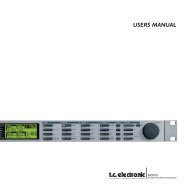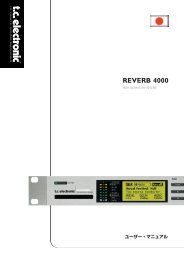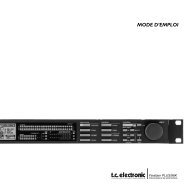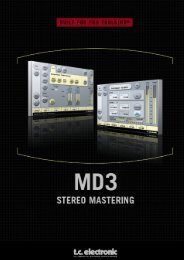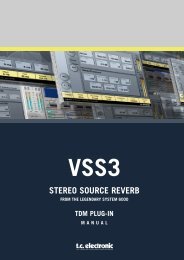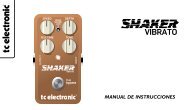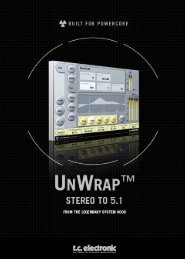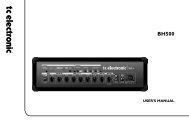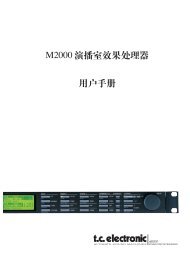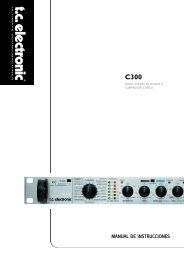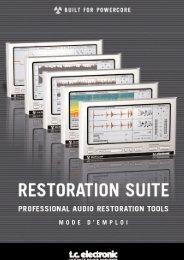EQ Station Manual v. 2.01 sw. 220 English - TC Electronic
EQ Station Manual v. 2.01 sw. 220 English - TC Electronic
EQ Station Manual v. 2.01 sw. 220 English - TC Electronic
Create successful ePaper yourself
Turn your PDF publications into a flip-book with our unique Google optimized e-Paper software.
GRAPHICAL <strong>EQ</strong> TYPES IN THE <strong>EQ</strong> STATION<br />
Q mapping: Constant or<br />
progressive Q, and which?<br />
Two single-band <strong>EQ</strong>s with the same center-frequencies<br />
and the same slider settings may differ greatly depending<br />
on the designer's choice of Q as a function of Gain setting,<br />
as the following 3 examples will show:<br />
Naturally there is an infinite number of possible Q<br />
mappings, the examples shown are rather extreme.<br />
Structure dependent multi-band<br />
gain build-up<br />
Even with identical center frequencies, gain settings and<br />
Qs, the responses of two graphical equalizers may differ<br />
significantly when multiple bands are applied. This is due to<br />
the structure dependent multi-band gain build-up. We will<br />
look at 3 different implementation structures with different<br />
multi-band gain build-up properties.<br />
Parallel BP feed-forward/feed-back structure<br />
This structure which has been used in the <strong>TC</strong> 1128 and its<br />
<strong>EQ</strong> <strong>Station</strong> digital twin produces relatively little gain buildup.<br />
Since it is based entirely on summation of BP filtered<br />
signals, the responses of individual BP filters are added in<br />
the absolute domain, not the dB domain.<br />
Figure 8 - Three-band boost (i.e. feed-forward only)<br />
extract of Parallel BP feed-forward/feed-back <strong>EQ</strong><br />
structure.<br />
Figure 9 - Three-band boost extract of Cascade-ofbiquads<br />
<strong>EQ</strong> structure.<br />
Figure 7 a/b/c - Three different examples of Q mapping<br />
Note that the above used " Input + gain•BP" structure from<br />
Figure 2 can be contained in a single bi-quadratic filter,<br />
a.k.a. 'a biquad'. This structure is used in <strong>EQ</strong> <strong>Station</strong>'s<br />
'Classic27' algorithm.<br />
15




